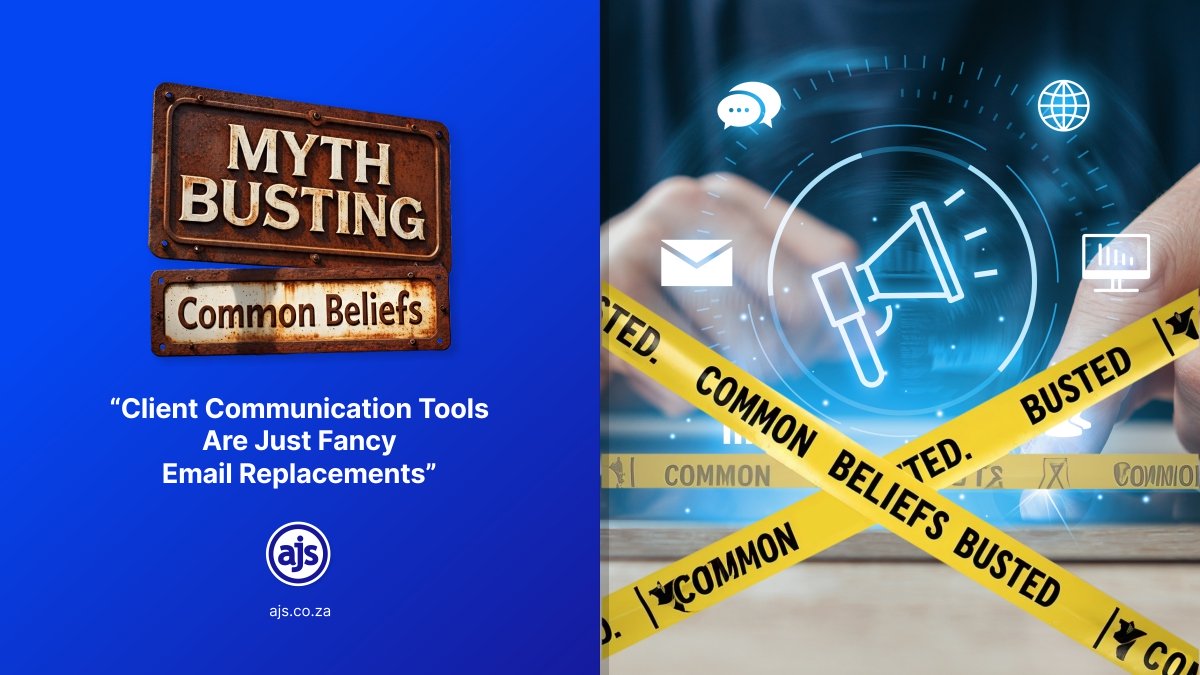
MYTH BUSTING COMMON BELIEFS: Part 7
Like “Client Communication Tools Are Just Fancy Email Replacements.”
Wherever you look people are communicating.
Whether it’s via WhatsApp, direct messaging on Instagram, LinkedIn, or Facebook, or an alternative professional communication platform tool like Zoom, Microsoft Teams, or Slack.
We spend our days chatting away with clients, with colleagues, with friends and family. Communication – it seems – is the single most powerful tool available to every human being on the planet. And in this regard, two quotes come to mind –
Words are singularly the most powerful force available to humanity. We can choose to use this force constructively with words of encouragement or destructively using words of despair. Words have energy and power with the ability to help, to heal, to hinder, to hurt, to harm, to humiliate and to humble. – Yehuda Berg (American author).
And
Words are, of course, the most powerful drug used by mankind. – Rudyard Kipling (English novelist).
Opposable thumbs might differentiate us from the beasts but truthfully it comes down to words – the amazing ability we have to communicate with one another. Without words and without effective communication we are no better off than the animals. And evolution has come a little too far down the line to neglect our G-d given gift.
The way we communicate has filtered down into businesses which – in today’s fast paced, digitally enhanced, connected world – centres around how they communicate – whether it’s through their content creation (in order to become thought leaders), communicating with potentially irate clients via a social media platform (in order to prevent reputational damage), communicating with a colleague (over a mutual matter they are working on) or whether it’s simply speaking to suppliers or service providers, effective communication (in all its various forms) is key.
The bottom line is this – if you’re not online or available via some form of messaging service, you are – very quickly – being left behind.
So, when there’s talk about how client communication tools are just “fancy email replacements”, we feel we need to step in and dispel with the misconception.
Because that simply isn’t true.
While an email and client communication tool both facilitate communication, specialised tools offer distinct advantages over standard email, including better organisation, advanced security, and features designed to enhance the client experience.
- Wait. What’s a client communication tool actually?
According to Content Snare, a client communication tool is a business tool that companies use to collaborate with clients. They allow for the exchange of information in the form of written messages, files, images, documents, and forms. Client communication tools look like email inboxes, messaging apps, data collection tools as well as other formats.
But don’t just take our word for it, let us prove it to you…
The limitations of email for client communication
While the tried and tested email is – we admit – a quick and accessible form of communication, it has quite a few drawbacks for managing professional client relationships –
1. Lack of organisation – think of long email threads, communication is often scattered across multiple, confusing threads, making it easy for valuable information to get lost, buried or misunderstood along the way.
2. Security risks – with data breaches being such a hot topic, it’s crucial that you understand that standard email is not secure enough for sending sensitive information like financial or personal data, which can lead to data breaches, hacks, and ransomware.
3. Poor context – can you really get the gist of everything through an email thread? What users will find is that there is often a lack of a centralised, clear overview of a project’s status, requiring both parties to search through their inboxes for context. And that’s just a waste of time!
4. Misinterpretation – words on a page may be wonderful to read but sometimes without the benefit of tone of voice, body language, or a personal connection, the written word can easily be misinterpreted.
5. Inefficient for files and feedback – during big projects where there’s a plethora of documents and paperwork, the sharing and approving of files can be a clunky process, often involving multiple back-and-forth email attachments and unclear feedback. Who has time for that?
6. Information overload – who likes an overflowing inbox? It can be overwhelming, stressful and lead to anxiety. Not only that but it can also lead to delays in responses and missed information. And this is not ideal, especially when a big deal or matter is on the line.
How a specialised client communication tool can go beyond email
Now with dedicated communication platforms, there is an array of capabilities that address the shortcomings of email. For instance –
1. Centralised and organised communication – instead of isolated threads, platforms like client portals or shared inboxes provide a single, secure space for all client interactions, files, and project updates. Making keeping up to date with the latest occurrences a breeze! Why do we say this, well –
- Integrated context – team members have a unified view of the customer’s history and current project status.
- Threaded messaging – many tools offer internal notes and threaded comments that prevent internal discussions from cluttering the client-facing conversation, keeping communication focused and clear. Making reporting to clients much easier.
- Project management – integrated tools can manage tasks, assign roles, and track deadlines, providing transparency into project progress for both clients and internal teams. No more stress trying to ascertain the crux of things. It’s all there in plain sight for everyone to see. How easy peasy!
- Wait. What is a client portal actually?
According to Swell Enterprise, a client portal is a secure online platform that provides your clients with a central location to access their important documents, track progress, and interact with your business. Think of it as a personalized, digital space where clients can view the status of their projects, download files, communicate directly with your support team, and much more.
Unlike traditional communication methods, which can be fragmented, client portal software offers a unified system with built-in features that enhance customer experience and customer satisfaction. Whether you’re a small business or a larger company, the right client portal app can help you stay organized and improve overall communication with your clients.
2. Enhanced security and privacy – client portals and other tools are designed with robust security features that are absent in standard email. And this is crucial for law firms who are required by law (the Protection of Personal Information Act 4 of 2013) to –
- Secure file sharing – sensitive documents like contracts and financial records can be exchanged through an encrypted, password-protected portal, preventing data from being compromised (and keep those darn cyber criminals at bay).
- Control over access – access to information can be controlled with user authentication and granular permissions, ensuring only authorised individuals can view certain documents.
3. Streamlined workflow and automation – these tools improve operational efficiency by automating routine tasks and providing built-in features for common workflows through –
- Faster feedback – features that allow clients to provide direct feedback with annotations on a file or document remove the need for confusing email explanations.
- Automated tasks – assign tasks and send automatic follow-up emails. All instant, all automated, all done.
- Self-service options – many tools offer integrated help centres or client support, allowing clients to find answers to their own questions 24/7 without waiting for a response.
4. A better client experience – by centralising all interactions, specialised tools create a more professional and intuitive experience for clients. And this results in –
- Improved engagement – the transparency and 24/7 access to information can increase client engagement, build trust, and foster stronger relationships. For clients, just knowing that you are “there for them” makes all the difference.
- Branded interface – many platforms are “white-label,” allowing businesses to add their own logo and branding to provide a seamless and professional client experience.
It would seem that with the above set out, client communication tools are “the right tool for the job”. While email is still effective for simple, non-sensitive exchanges, specialised communication tools are far more capable for complex, ongoing client work that involves project management, secure file sharing, and multiple stakeholders.
For businesses seeking to improve their operational efficiency and enhance their client relationships, treating these platforms as more than just a “fancy email” is the key to unlocking their full potential.
We think that the answer to this conundrum is plain for all to see – the myth about client communication tools just being “fancy emails” is BUSTED! Trying to run a business from your email inbox is – as we set out above – a recipe for chaos. Between scattered threads, missed attachments, and endless CCs, even the most organised professional eventually hits a wall. What starts as a convenient way to communicate quickly turns into a bottleneck of miscommunication and lost productivity. And “nobody got time for that!”
If you are in need of a service provider who has a proven track record or if you want to find out how to incorporate a new tool into your existing practice management suite – or if you simply want to get started with legal tech – feel free to get in touch with AJS. We have the right combination of systems, resources, and business partnerships to assist you with incorporating supportive legal technology into your practice. Effortlessly.
AJS is always here to help you, wherever and whenever possible!
– Written by Alicia Koch on behalf of AJS
(Sources used and to whom we owe thanks – Content Snare; Project.co; Swell System; Desk Alerts and Workway.pro)





Leave a Reply